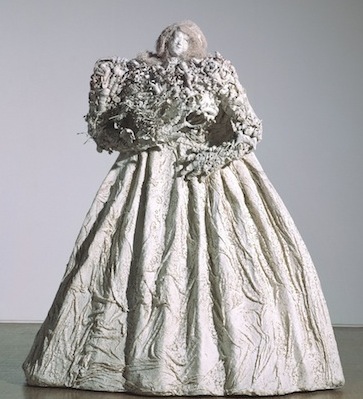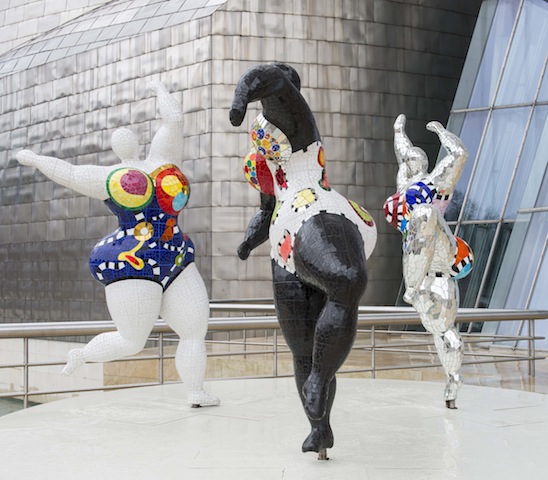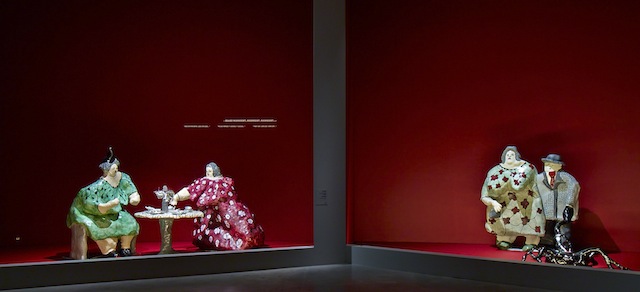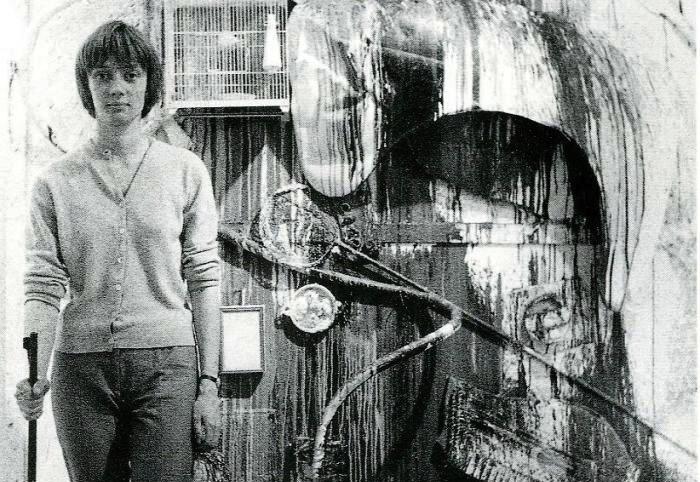This is work that wears its heart on its sleeve. That’s what gets you in the end in this big retrospective of the work of Niki de Saint Phalle. The French-American artist, who died aged 71 in 2002, is probably best known for two very different bodies of work: her Shooting paintings, the series of collaborative performances in which she and others blasted paint-filled polythene pouches with a rifle, creating chance-based abstract paintings as the sacs burst over the white-plastered canvases they were attached to; and her exuberant Nanas, a nimble, tippy-toed troupe of gargantuan women, fat-bottomed and huge-breasted, with small, faceless mannequin heads.
Brash, bold and brassy, the sizzling carnival colours of these voluptuous Amazons will, it is no doubt true, either make you smile or wince. They represent, as Saint Phalle herself said, an uncomplicated surrender to joy, made at a time when the fiery artist finally felt liberated from the emotional torments and turmoil of her 20s and early 30s. They come as quite a contrast to the violence of the shot pieces, made just a few years earlier at the start of the Sixties, when Saint Phalle was associated with French nouveau réalisme, a group whose members included Yves Klein and her future husband, the kinetic sculptor Jean Tinguely. But still, one can’t be entirely sure of their benign character, not least because of their monstrous size, and their mind-less Dionysian abandon. Their appetites, in every sense, appear insatiable.
She took up art, she said, to rescue her sanity
Giant women appear in different guises throughout this sizable survey at Guggenheim Bilbao, a venue which last year saw a major retrospective of another female artist, a contemporary of Saint Phalle’s but one who’s still going strong: Yoko Ono. Like that one, this is the first such comprehensive survey of the artist. And in Saint Phalle’s case, the location, especially given the profound influence of the Spanish architect Antoni Gaudí, seems particularly fitting. You can see the impact that La Sagrada Familia had on the artist after her first visit to Barcelona, which the artist describes as revelatory, with many of her early canvases covered in broken ceramic tiles, crockery and shells. Furthermore, there’s just something deeply Mediterranean, or Southern European at least, in her sensibility – the hot colours, the exuberance and boldness, that makes the work seem right at home here.
Saint Phalle would later expand her repertoire of collage materials to include toys and a range of domestic objects – anything, really, that seemed close to hand, though toys feature most prominently, powerfully suggesting a sense of lost childhood. One work, from 1961, combines a collage and a shooting painting (a choice verb, since the work is a tribute to an artist famous for his “combines”). The work, called Homage to Bob Rauschenberg (Shot by Rauschenberg), features objects such a wellington boot, a milk jug, an aerosol can, crushed cans, and the head of a mop, on a long wooden shutter, all painted white, though rivulets of red, blue and grey paint from the exploded pigment-containing sacs have created a scene of apparent forensic carnage. It looks just like one of Rauschenberg’s Combines. Another shooting painting is of a large target, shot by Jasper Johns, and a homage to the American artist's target paintings.
 And then of course we have the giant women again, popping up as female archetypes: as brides in tatty weeds of white, with one plonked side-saddle on a rickety mare, or as prostitutes or as barbarous-looking housewives or as dumbly suffering mothers, some in the process of giving birth. Plastic dolls enact the event, as if placed there by a child playing a secret game of grown-ups with her toys. (Pictured right: The Bride, 1963)
And then of course we have the giant women again, popping up as female archetypes: as brides in tatty weeds of white, with one plonked side-saddle on a rickety mare, or as prostitutes or as barbarous-looking housewives or as dumbly suffering mothers, some in the process of giving birth. Plastic dolls enact the event, as if placed there by a child playing a secret game of grown-ups with her toys. (Pictured right: The Bride, 1963)
These pre-Nanas are often modelled from plaster over a wire framework, painted and embedded with toys which cover surfaces like crustaceans, while the later, exuberantly dancing Nanas (the French colloquialism roughly translates as the outmoded "chicks") are made of polyester, their smooth surfaces painted and sometimes decorated with materials such as a mirror mosaic.
Veering into gothic territory, there’s also the recurring Catholic imaginary. Assemblages of crucifixes and sacred hearts and skulls and tiny plastic babies – sometimes dozens, even hundreds of these plastic infants piled high as if in catacombs – feature in makeshift altars. But these works often appear less like appropriations of Catholic imagery and more like Voodoo charms used in forbidding rituals. Saint Phalle apparently rejected Catholicism, but, like many Catholics, clearly found it had worked its way under her skin and she couldn’t quite shake it off. In any event, later photographs find her wearing huge crucifix necklaces. Clearly her relationship to the religion of her birth was, let us say, a complicated one.
Born just outside Paris into a conservative, upper-class family, Saint Phalle spent most of her childhood and young adulthood in America, before returning to France, though not indefinitely, to practice as an artist. But before she turned to art professionally – she was entirely self-taught but was quick to find herself absorbed in artistic circles (and there is a definite quality of the “outsider artist” in her bluntly naïve early canvases which seem genuinely raw and unpractised compared to, say, the sophisticated naiveté of someone like Dubuffet, whom she also cites as an influence) – she was a model.
 And, as a model, what a contrast to the depiction of blowsy womanhood that Saint Phalle favoured in the Nanas (pictured above: The Three Graces, 1995-2003, at Guggenheim Bilbao). As we step into the first gallery, we find a very young, very petite and coolly elegant Saint Phalle in a series of blown-up black and white photographs. Here she is as a cover girl on French Vogue as well as other impossibly glamorous high-fashion magazines. There she is again, feasting her eyes on us with an alluringly lowered gaze, a cigarette in its holder between gloved fingers, while, with the other hand, she delicately prods an ice cream sundae with a spoon. But – and doesn’t it often? – that beautiful cool exterior hid a deeply troubled past.
And, as a model, what a contrast to the depiction of blowsy womanhood that Saint Phalle favoured in the Nanas (pictured above: The Three Graces, 1995-2003, at Guggenheim Bilbao). As we step into the first gallery, we find a very young, very petite and coolly elegant Saint Phalle in a series of blown-up black and white photographs. Here she is as a cover girl on French Vogue as well as other impossibly glamorous high-fashion magazines. There she is again, feasting her eyes on us with an alluringly lowered gaze, a cigarette in its holder between gloved fingers, while, with the other hand, she delicately prods an ice cream sundae with a spoon. But – and doesn’t it often? – that beautiful cool exterior hid a deeply troubled past.
In her early 20s, soon after becoming a mother and trying to settle down to domestic life with her first husband, the American writer Harry Mathews, Saint Phalle had a serious mental breakdown, for which she was hospitalised and underwent electroshock and insulin therapy (the initial diagnosis was schizophrenia). She took up art, she said, to rescue her sanity. Much later she would write that her father had raped her when she was 11, an abuse she documents again, or at least strongly alludes to if not explicitly recounts, in a biographical series of crude, colourful and creepily jaunty cartoon-like drawings on paper.
 The cartoons that allude to her abuse gave rise to a series of sculptural “story-book” tableaux featuring a fat, domineering, bourgeois “mother” and, interestingly, an almost inconsequential “father”, who makes only a couple of appearances in the series, including one in his coffin where he is attended by the mourning matriarch. In one of the pieces, the mother is walking a huge scorpion as it if were a dog, a striking metaphor for that dark, unspoken thing in the family (pictured above).
The cartoons that allude to her abuse gave rise to a series of sculptural “story-book” tableaux featuring a fat, domineering, bourgeois “mother” and, interestingly, an almost inconsequential “father”, who makes only a couple of appearances in the series, including one in his coffin where he is attended by the mourning matriarch. In one of the pieces, the mother is walking a huge scorpion as it if were a dog, a striking metaphor for that dark, unspoken thing in the family (pictured above).
These works are installed in a powerful theatrical setting, each "scene" in a separate cubicle, like proscenium stages that encircle the space, against blood-red walls. At around the same time, she also collaborated on a feature-length film called Daddy, 1973, with Peter Whitehead, a counterculture filmmaker of the Sixties who’d worked with the Rolling Stones and Pink Floyd. That film also tackles the abuse. But it’s the theatrical tableaux that are the visceral highlight of an exhibition exploring the work and life of an artist who, for a long time after her death, appeared to have dropped out of favour with the art establishment.









![SEX MONEY RACE RELIGION [2016] by Gilbert and George. Installation shot of Gilbert & George 21ST CENTURY PICTURES Hayward Gallery](/sites/default/files/styles/thumbnail_125_x_125_/public/mastimages/Gilbert%20%26%20George_%2021ST%20CENTURY%20PICTURES.%20SEX%20MONEY%20RACE%20RELIGION%20%5B2016%5D.%20Photo_%20Mark%20Blower.%20Courtesy%20of%20the%20Gilbert%20%26%20George%20and%20the%20Hayward%20Gallery._0.jpg?itok=3oW-Y84i)





Add comment